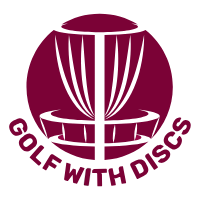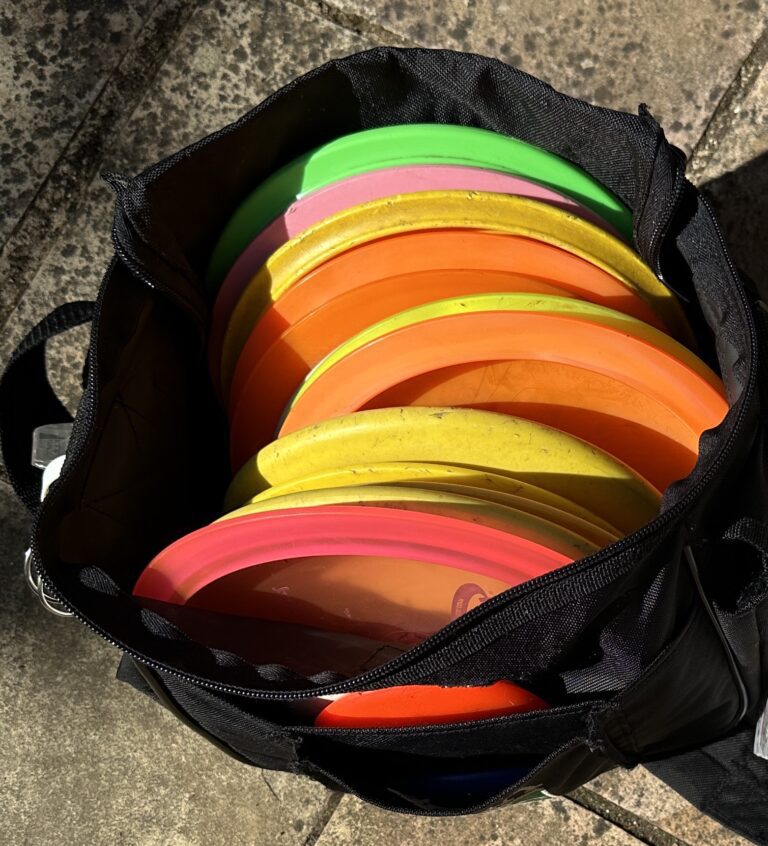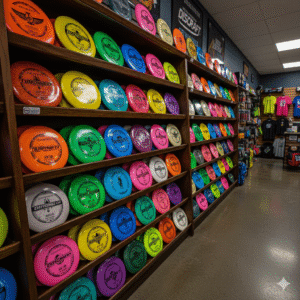Looking for a fun, social activity that gets you outdoors? Ever tried a sport that combines the precision of golf with the casual fun of tossing a Frisbee®? Disc golf is the perfect blend of physical activity, strategic thinking, and friendly competition—great for all ages, from kids to disc golf for seniors. This comprehensive beginner disc golf guide will give you the basics to navigate the fairways and improve your game. So gather your friends, lace up your shoes, and get ready to tee off on a new adventure!
Your Beginner Disc Golf Guide to Fun and Adventure
Picture this: the carefree joy of tossing a Frisbee® meets the strategic depth of golf—without the awkward polos or hefty price tags. That’s disc golf! This beginner disc golf guide is your passport to mastering the game while having a blast. Whether you’re aiming for the basket or just hoping to dodge a few trees, we’ve got you covered.
How to Level Up Your Disc Golf Game
Improving in disc golf is a bit like baking the perfect cake—leave out one ingredient, and you end up with a soggy mess. The secret recipe? The right discs, sharp technique, a sprinkle of strategy, and a dollop of mental focus. With these essentials, you’ll soon be conquering fairways and impressing your friends (or at least avoiding the water hazards).
Dive deep into the essentials of disc golf, from choosing the right discs to becoming good at the game:
- The Professional Disc Golf Association (PDGA) offers a wealth of resources for beginners and seasoned players alike.
- The Disc Golf Course Review (DGCR) website boasts a massive database of disc golf courses worldwide, complete with detailed reviews, photos, and user ratings.
How to Build Your Beginner Disc Golf Bag
Choosing your first disc is like selecting the right wand in Harry Potter—yes, it matters that much. The wrong choice can send you spinning into frustration, while the right one feels like magic in your hand. For beginners, understable discs are your secret weapon—designed for forgiveness and control, they’re your shortcut to building confidence and nailing those sweet, straight throws.
- Disc Types: Disc golf discs fall into three main categories:
- Drivers: Designed for maximum distance, drivers are the powerhouses of the disc golf world. However, their erratic flight patterns can be challenging for beginners. Opt for discs with “understable” characteristics, offering a more forgiving and controllable flight path.
- Midranges: The versatile workhorses of the disc golf bag, midrange discs offer a balanced blend of distance and accuracy. They’re ideal for a variety of shots, making them perfect for beginners honing their throwing technique.
- Putters: The epitome of precision, putters are designed for short-range approach shots and, of course, putting. These discs prioritize accuracy and control, enabling you to sink those crucial birdie putts.
- Flight Numbers: Each disc displays a series of four numbers that provide valuable insights into its flight characteristics. Understanding these numbers will empower you to make informed disc selections:
- Speed: This number indicates the disc’s overall speed potential, ranging from 1 (slow) to 14 (fast). Beginners should gravitate towards discs in the 6-9 speed range for better control.
- Glide: Reflecting a disc’s ability to stay airborne, glide is usually represented by a number between 1 and 7. Higher glide discs (around 4 or 5) can help beginners achieve greater distance without exerting an excessive amount of force.
- Turn: This number represents a disc’s tendency to turn in a specific direction during flight. A negative number (e.g., -2) signifies a disc that’s more likely to veer right, which is generally beneficial for beginners.
- Fade: The final number denotes a disc’s fade at the end of its flight path. Positive numbers (e.g., 1) indicate a reliable and gentle fade towards the left at the end of the throw, promoting a controlled landing.
- Number of Discs: It’s tempting to amass a vast disc collection right out of the gate, but for beginners, starting small is key. A starter set typically includes a putter, a midrange disc, and a driver, offering a well-rounded selection for navigating most courses. As you progress, you can gradually expand your disc arsenal to address specific course challenges and shot types.
You can technically play disc golf with just one disc (a putter). However, for beginners, a starter set typically includes a putter, a midrange disc, and a driver, offering a well-rounded selection for navigating most courses. As you progress, you can gradually expand your disc arsenal to address specific course challenges and shot types.
Here are some popular disc recommendations for beginners:
- Putter: Innova Aviar (Loft Hydrogen is a great choice also)
- Midrange: Discraft Buzzz (Discraft Mako3 is another solid choice)
- Driver: Innova Leopard (MVP Volt is a good alternative)
These discs are known for their user-friendly flight characteristics and are perfect for helping beginners develop proper throwing technique and build confidence on the course.
Understanding the Four Numbers on a Disc Golf Disc
Those four cryptic numbers on a disc aren’t just decoration—they’re your cheat sheet for better throws. Think of them as the “nutrition facts” for your disc, except instead of calories, they tell you how fast, far, and predictably it will fly. For beginners, start with lower-speed discs (6–8) and higher glide ratings (4–5). Trust me—less is more until you’ve mastered the art of control.
- Speed (Number 1): This number doesn’t necessarily equate to throwing distance for beginners. While higher speed discs can travel farther in the hands of experienced players, their faster flight patterns require more finesse and power to control. Beginners should prioritize discs in the 6-9 speed range to focus on developing proper throwing form and accuracy.
Here’s a helpful analogy: Imagine throwing a ping pong ball versus a baseball. The ping pong ball (representing a slower speed disc) is easier to control due to its lighter weight and slower airspeed. Conversely, the baseball (representing a higher speed disc) requires more strength and technique to throw accurately.
- Glide (Number 2): Glide plays a crucial role in achieving distance, especially for beginners in the realm of disc golf discs. Discs with higher glide ratings (typically 4 or 5) tend to stay airborne for longer periods, allowing you to cover more ground with each throw even without exerting maximum power. This can be a significant advantage for beginners who are still building their throwing muscles.
- Turn (Number 3): The turn number indicates a disc’s tendency to turn in a specific direction during flight. Negative turn ratings (e.g., -2) signify understable discs, which are more likely to curve to the right during flight. This characteristic can be beneficial for beginners as it allows for a more forgiving and controllable flight path.
Think of it this way: If you throw an understable disc with a slight hyzer release angle (tilted at an angle towards the ground), it will likely straighten out or even curve slightly to the right before fading back at the end of the flight. This predictable flight path makes understable discs ideal for beginners who are still learning throwing mechanics.
- Fade (Number 4): The fade number represents a disc’s tendency to “fade” (turn left) towards the end of its flight path. Positive fade ratings (e.g., 1) indicate discs that will exhibit a gentle and predictable leftward turn at the end of the throw, promoting a controlled landing near the basket. This characteristic is especially helpful for approach shots and putting as it allows the disc to “fight” into the wind and settle softly near the target.
Understanding these four numbers empowers you to make informed disc selections based on your skill level, throwing style, and course conditions, ultimately enhancing your disc golf disc guide knowledge.
The Psychology of Disc Golf Flight Numbers
The four numbers on a disc golf disc might seem as mysterious as a tax code, but they hold the key to a better game. For beginners, here’s the psychological trick: don’t aim for the fastest or most “impressive” disc. Instead, start with slower discs (Speed: 6–8) and focus on control. Why? Because humans are notoriously bad at estimating their own skill level—a concept known as the Dunning-Kruger effect. Start simple, build confidence, and let your discs grow with your skills.
How to Add Distance Without Losing Your Disc
Ah, the quest for distance—it’s the Holy Grail of disc golf. But chasing it blindly is a rookie mistake. Imagine firing a cannon without aiming—it’s all power, no purpose. Instead, focus on technique: a firm snap, smooth hip rotation, and the right disc can unlock serious distance. Think of it as a dance—fluid, precise, and a whole lot of fun.
Instead:
- Master the Art of the Snap: The snap at the end of your throw adds spin, and spin means distance. Imagine flicking a towel—same principle, less laundry.
- Use Your Hips: Your hips are the unsung heroes of a great throw. They store power like a wind-up toy, releasing it in one smooth motion.
- Choose Wisely: An understable disc can give you that satisfying glide, even if you haven’t mastered your technique.
With these techniques, you’ll be throwing farther and straighter—without having to apologize to the people on the next fairway.
Unveiling the Secrets of Overstable and Understable Discs for Different Shot Types
The world of disc golf discs extends beyond simple distance drivers. Discs come in a variety of stability profiles, categorized as overstable, neutral, and understable. Understanding these stability profiles is crucial for understanding different shot types and becoming a well-rounded disc golf player:
The world of disc golf discs extends beyond simple distance drivers. Discs come in a variety of stability profiles, categorized as overstable, neutral, and understable. Understanding these stability profiles is crucial for becoming proficient at different shot types and becoming a well-rounded disc golf player in your journey through the world of disc golf:
- Overstable Discs: These discs, characterized by positive turn ratings and fade ratings, exhibit a more resistant flight path. They tend to resist turning right during flight and finish with a pronounced leftward fade at the end. Overstable discs are ideal for:
- Headwind shots: The wind resistance of overstable discs makes them perfect for battling strong headwinds that would otherwise push understable discs off course.
- Skip shots: Overstable discs excel at skipping off the ground and around obstacles due to their tendency to “fight” out of turns and fade sharply at the end.
- Forehand throws: For right-handed throwers, overstable discs can be helpful for forehand throws as their inherent fade counteracts the natural tendency of forehand throws to turn over (curve to the right) excessively.
- Neutral Discs: Neutral discs, as the name suggests, exhibit a relatively straight flight path with minimal turn and fade. They are ideal for:
- Fairway drivers: These versatile discs bridge the gap between distance drivers and midranges, offering a good balance of speed and control for navigating fairways.
- Technical shots: Neutral discs can be useful for precise throws requiring a straight flight path, like navigating tight corridors or executing controlled hyzer flips (where the disc flips up from an understable release angle to a stable flight path).
- Understable Discs: As discussed previously, understable discs (negative turn ratings) are more likely to curve right during flight and exhibit a gentler fade at the end. These discs are ideal for:
- Tailwind shots: Understable discs can take advantage of tailwinds (winds blowing in the same direction as the throw) to achieve additional distance.
- Turnover shots: These involve intentionally throwing the disc with an anhyzer angle (tilted away from the ground) to curve right and then fade back left towards the target. Understable discs are well-suited for this type of shot due to their inherent rightward turning tendency.
- Tunnel shots: Understable discs can navigate tight fairways and corridors due to their ability to curve around obstacles before fading back towards the target.
Understanding these stability profiles and their applications empowers you to select the right disc for the job, enhancing your shot diversity and course strategy. This is a crucial aspect of understanding disc golf and becoming a well-informed player.
A Beginner’s Guide to Playing Disc Golf
Now that you’re equipped with the essential knowledge about discs and throwing techniques, let’s delve into the actual gameplay of disc golf, putting your disc golf disc guide knowledge to practice:
- The Basics: Disc golf is played similarly to traditional golf, but instead of using clubs and balls, players throw discs towards a metal basket with chains suspended on top. The objective is to complete each hole in the fewest throws possible. A typical disc golf course consists of 9 or 18 holes, and the player with the lowest total score at the end of the round wins.
- Gameplay: Here’s a breakdown of a typical disc golf hole:
- Tee Pad: Each hole begins with a designated teeing area, typically marked by a concrete pad or a patch of artificial turf. Players must initiate their throws from within the designated tee pad boundaries.
- Fairway: The fairway is the designated playing area between the tee pad and the basket. It can vary in terrain, incorporating elements like trees, bushes, water hazards, and elevation changes.
- Basket: The target on each hole is a metal basket with chains suspended on top. A successful throw involves getting the disc to land inside the basket or resting within the chains.
- Throwing Order: Players typically take turns throwing their discs towards the basket. The player who finishes a hole with the fewest throws takes the first throw on the next hole.
Essential Disc Golf Etiquette
Maintaining proper disc golf etiquette demonstrates courtesy towards fellow players and protects the course itself:
- Wait Your Turn: Allow other players to complete their throws before making your own. This ensures safety and prevents distractions.
- Silence is Golden: When another player is lining up their putt, avoid loud talking, excessive movement, or disruptive noises like cellphone ringtones. Maintaining a quiet atmosphere allows them to focus and execute their putt with proper concentration.
- Yield to Faster Groups: If a faster group approaches you on the course, be courteous and allow them to play through.
- Respect the Course: Disc golf courses typically traverse natural environments. Be mindful of your surroundings and avoid littering, damaging trees or plants, or creating shortcuts through rough terrain. Remember, respecting the course ensures a pleasant experience for everyone who plays it.
The Surprising Psychology Behind Disc Golf’s Popularity
Disc golf’s magic lies in its universal appeal. It’s a sport that doesn’t care about your age, income, or athletic prowess—it meets you exactly where you are. Here’s why:
- Loss Aversion Meets Affordability: Traditional golf comes with green fees and expensive clubs, but disc golf sidesteps these barriers. A starter set costs less than dinner at a fancy restaurant, making the sport feel low-risk yet highly rewarding.
- The Joy of Incremental Improvement: Humans thrive on small wins, and disc golf delivers in spades. Each throw, each hole, each game offers an opportunity to improve—a concept known as “variable rewards.”
- Social Connection Without Pressure: Whether you’re playing solo or with friends, disc golf fosters connection. It’s casual enough to avoid the pressure of formal sports but structured enough to keep you engaged.
This blend of accessibility, progression, and social satisfaction explains why disc golf resonates with people of all ages and backgrounds.
Disc golf offers a low barrier to entry compared to traditional golf. The equipment is relatively inexpensive. Discs can range from $10 to $30 each, and many courses are free to play. This makes disc golf an accessible and budget-friendly sport for people of all backgrounds.
Absolutely! Disc golf is a fantastic social activity, but it can also be enjoyed solo. Playing a local disc golf course by yourself allows you to hone your skills at your own pace and experiment with different throws. Additionally, you can create a makeshift disc golf course in your backyard using trees, baskets, or even strategically placed cones as targets
Disc golf’s surging popularity can be attributed to several factors that make it a compelling sport for people of all ages and backgrounds:
- Accessibility: Disc golf offers a low barrier to entry. The equipment is relatively inexpensive compared to traditional golf, and many courses are free to play.
- Social Activity: Disc golf can be enjoyed solo, but it also thrives as a social activity. Playing with friends or joining a local disc golf club fosters camaraderie and a sense of community.
- Outdoor Activity: Disc golf gets you outdoors, allowing you to connect with nature and enjoy the fresh air. It’s a fantastic way to escape the monotony of indoor routines and experience the beauty of your surroundings.
- Challenge and Reward: Disc golf offers a satisfying blend of physical activity, mental challenge, and strategic thinking. Perfecting throws, navigating complex courses, and sinking clutch putts provide a rewarding sense of accomplishment.
- Lifetime Sport: Unlike some sports that become increasingly challenging with age, disc golf can be enjoyed by people of all ages and fitness levels. It’s a fantastic way to stay active and engaged in a fun and social environment throughout your life.
This comprehensive disc golf 101 guide has armed you with the knowledge and skills to conquer the course! Grab your discs, gather your friends, and get ready to experience the exhilarating world of disc golf. Fresh air, friendly competition, and the satisfying clang of a disc landing in the basket – disc golf awaits! Remember, practice makes perfect, but most importantly, have fun out there!






